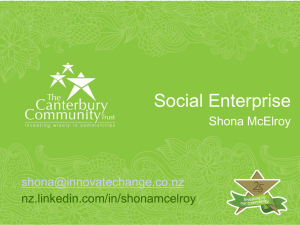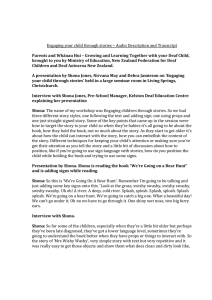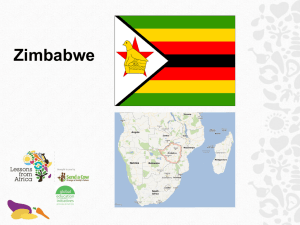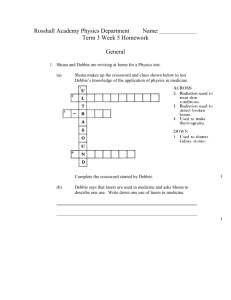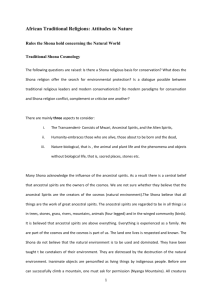Document 10465449
advertisement
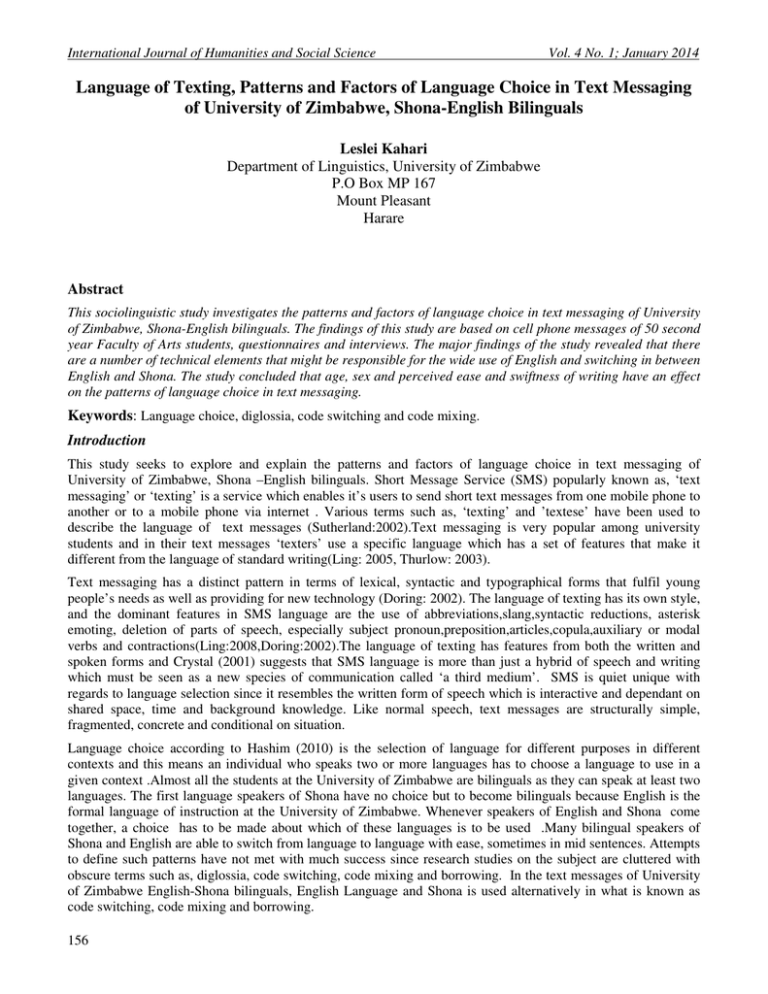
International Journal of Humanities and Social Science Vol. 4 No. 1; January 2014 Language of Texting, Patterns and Factors of Language Choice in Text Messaging of University of Zimbabwe, Shona-English Bilinguals Leslei Kahari Department of Linguistics, University of Zimbabwe P.O Box MP 167 Mount Pleasant Harare Abstract This sociolinguistic study investigates the patterns and factors of language choice in text messaging of University of Zimbabwe, Shona-English bilinguals. The findings of this study are based on cell phone messages of 50 second year Faculty of Arts students, questionnaires and interviews. The major findings of the study revealed that there are a number of technical elements that might be responsible for the wide use of English and switching in between English and Shona. The study concluded that age, sex and perceived ease and swiftness of writing have an effect on the patterns of language choice in text messaging. Keywords: Language choice, diglossia, code switching and code mixing. Introduction This study seeks to explore and explain the patterns and factors of language choice in text messaging of University of Zimbabwe, Shona –English bilinguals. Short Message Service (SMS) popularly known as, ‘text messaging’ or ‘texting’ is a service which enables it’s users to send short text messages from one mobile phone to another or to a mobile phone via internet . Various terms such as, ‘texting’ and ’textese’ have been used to describe the language of text messages (Sutherland:2002).Text messaging is very popular among university students and in their text messages ‘texters’ use a specific language which has a set of features that make it different from the language of standard writing(Ling: 2005, Thurlow: 2003). Text messaging has a distinct pattern in terms of lexical, syntactic and typographical forms that fulfil young people’s needs as well as providing for new technology (Doring: 2002). The language of texting has its own style, and the dominant features in SMS language are the use of abbreviations,slang,syntactic reductions, asterisk emoting, deletion of parts of speech, especially subject pronoun,preposition,articles,copula,auxiliary or modal verbs and contractions(Ling:2008,Doring:2002).The language of texting has features from both the written and spoken forms and Crystal (2001) suggests that SMS language is more than just a hybrid of speech and writing which must be seen as a new species of communication called ‘a third medium’. SMS is quiet unique with regards to language selection since it resembles the written form of speech which is interactive and dependant on shared space, time and background knowledge. Like normal speech, text messages are structurally simple, fragmented, concrete and conditional on situation. Language choice according to Hashim (2010) is the selection of language for different purposes in different contexts and this means an individual who speaks two or more languages has to choose a language to use in a given context .Almost all the students at the University of Zimbabwe are bilinguals as they can speak at least two languages. The first language speakers of Shona have no choice but to become bilinguals because English is the formal language of instruction at the University of Zimbabwe. Whenever speakers of English and Shona come together, a choice has to be made about which of these languages is to be used .Many bilingual speakers of Shona and English are able to switch from language to language with ease, sometimes in mid sentences. Attempts to define such patterns have not met with much success since research studies on the subject are cluttered with obscure terms such as, diglossia, code switching, code mixing and borrowing. In the text messages of University of Zimbabwe English-Shona bilinguals, English Language and Shona is used alternatively in what is known as code switching, code mixing and borrowing. 156 © Center for Promoting Ideas, USA www.ijhssnet.com Even though many scholars have tried to define code switching ,code mixing and borrowing ,the definitions have failed to provide a clear distinction between the terms(Romaine:1989,Poplack:1988).Grosjean (1982:145)defines code switching as, ‘the alternate use of two or more languages in the same utterance or conversation’ which occurs when an individual who is bilingual alternates between two or more languages during his or her speech with another bilingual person. Code switching is best explained by diglossia and it is a situation in a given speech community where two or more varieties of a language exist side by side with each having a definite role to play (Ferguson: 1996, Myers-Scotton: 1993, Grosjean: 1982). Poplack (1988) identifies three types of code switching namely, tag switching, inter-sentential switching and intra-sentential switching. Tag switching relates to the insertion of tags such as ,’you know’ and ‘i mean’ in sentences that are completely in the other language, ,while inter-sentential switching involves switches from one language to another between sentences produced entirely in one language before there is a switch to the other language(Myers-Scotton:1993).Intra-sentential switching according to Poplack (1988) occurs in the same sentence or sentence fragment while borrowing involves direct borrowing of a word and the adoption of a word into the phonetic ,phonological or grammatical system of the other language(Campbell:1998).Since this study focuses on language choice ,the current study adopts the term code switching as an umbrella term which refers to any occasion of alternating between English and Shona. Appel and Muysken(1987)present a variety of perspectives from which language choice may be viewed and the dominant concepts within each perspective include, societal perspective(domains),language perspective(diglossia),speakers perspective(decision tree),interactional perspective (accommodation ) and functional perspective (referencial,expressive,metalinguistic and phatic). In language choice there are institutional contexts or domains in which one language is more likely to be appropriate than the other and such institutional contexts include, location, topic and participants (Fishman: 1967). The concept of Domain Analysis is closely related to diglossia which refers to the choice of the Low language (L) and the use of High Language (H) in more formal contexts such as, education and business showing that a language is not randomly used but is chosen according to the situation (Fishman:1967).The High(H) language variety is reserved for high function whilst Low(L) is reserved for the low functions meaning that one language is more likely appropriate than others in a certain domain. In this sense, language choice as pointed out by Makoni (1995) is also determined by the functions accorded to each of the languages involved. Languages can therefore exist in a diglossic relationship with one language being appropriate for a set of situations and inappropriate for others. The H language variety has been shown to be more superior to L language variety by having a sizeable body of written literature which is held with high esteem by the speech community and contemporary literary production (Makoni (1995). The H language variety is felt to be part of this otherwise existing literature and is shown to be standardized and having grammatical categories which are not present in L language variety. Children are deemed to learn the L variety in what may be regarded as the normal way of learning one’s mother tongue while H language variety is chiefly accompanied by the means of formal education (Makoni: 1995). In Zimbabwe as pointed out by Makoni (1995), English is considered to be a superior language and is given a higher status than Shona making speakers of English to have a higher status. The concept of domain is closely linked to referential functions of language choice also known as topic related switching, ‘which often involves lack of knowledge of one language or lack of facility in that language on a certain subject as certain subjects may be more appropriately discussed in one language, and the introduction of such a topic can lead to a switching’ (Gumperz and Hernandez-Chavez: 1998, 34). In such cases a word from one of the languages maybe semantically more appropriate for the given context. Directive function also influence language choice in the sense that the hearer is directly involved somehow, either by being induced or excluded by the switch to the other language .Giles’s (1979) Speech Accommodation Theory can be used to explain social motivation for code switching whereby a speaker chooses a language or language variety that seems to suit the needs of the person being talked to. A speaker might even deliberately make his speech maximally unlike the other persons and this can happen when the speaker wants to emphasise his loyalty to the shown group and dissociate himself from the interlocutors group. This theory is relevant to this study as it explains why one language can be chosen over the other in order to suit the environment or the needs of the person being communicated to. 157 International Journal of Humanities and Social Science Vol. 4 No. 1; January 2014 Metalinguistic function involves language choice commenting directly or indirectly on the languages involved for example, to impress the other participants with a show of linguistic skills. According to Bentahila (1983) any speaker of any language has at his disposition a range of language varieties and the speakers ability to choose the appropriate language variety for any particular purpose is part of communicative competence .This choice according to Bentahila (1983) is not random, but is determined by aspects of the social organisation of the communication and the social situation where the discourse takes place. Theoretical Framework The examination of text messages in this study is based on the New Literacy Studies Theory (NLST) (Barton: 2007, Barton and Hamilton: 1998 and Gee: 1996) which argues that reading and writing are more than decoding letters and words but rather but human activities in context. Texting is integrated in people’s everyday lives and according to Selfe and Hawisher (2004) it is not isolated from other forms of human activity in society since what texters want to do with their texts is partly shaped by what their linguistic resources can or cannot do for them. Many students use text messages to stay in touch with friends, relatives, to discuss about homework and to set up weekend activities (America Online, 2005).Such informal everyday use and exchange of text messages fosters the development of texting as a social practice associated with sets of values that influence students to use texts in specific ways. The patterns and factors of language choice in the text messaging of University of Zimbabwe students can be understood as ,‘text making practices’ which are considered a subset of ‘literary practices’ within a social theory of literacy, or what is called the New Literacy Studies Theory (Barton: 2007, Barton and Hamilton: 1998, Street: 1993). The NLS is relevant to the aims of this research because it brings together aspects of people, texts, literacy events and literacy practices. The NLS enabled the researcher to study text messages in terms of patterns and language choice as literary practices associated with ‘cultural ways of utilising literacy’ and their ‘associated values, attitudes ,feelings and social relationships’(Barton and Hamilton:2000,8).This paper is specifically concerned with patterns and factors of language choice in text messages which is closely related to NFLT ‘text-making practices’(Bazerman and Prior:2004). Language choice highlights the idea that each and every language is used in a particular context for a certain reason. In text messaging when a speaker of more than one language is sending a message, a language has to be chosen and the choice of language is determined by various factors. When a speaker has a range of languages within which to choose, that choice helps to define the occasion and purpose of that particular choice. An understanding of language choice also involves an understanding of people’s beliefs, perceptions, feelings and other values associated with the production and representational aspects of text messages. In considering literacy of new technologies, NLS researchers also focus on the relationship between affordances of semiotic resources and representational meanings. The concept of ‘affordances which is associated with the works of Gunther Kress (Kress: 2005) is defined by Bearne and Kress (2001, 91) as, ‘what is made possible and facilitated, and what is made difficult and inhibited’. This concept is helpful to an understanding of language choice because it takes into account both possibilities and constraints of language choice in text messages. Methodology The data for the study was collected using three techniques of data collection. Firstly, the participants drawn from the Faculty of Arts were asked to forward at least three text messages from their cell phone sent box to the researcher’s cell phone. The three text messages, one sent to a friend, one to parents and the third sent to a class mate were forwarded to the researcher. The second method was the use of an open ended questionnaire which was used to collect demographic information as well as ‘real’ text messages from participants who were willing to take part in the study but had failed to send sent text messages from their cell phone sent box to the researcher. The questionnaire also collected information on patterns and factors of language choice. The third method used was semi-structured interviews with 20 of the students who had completed the questionnaires or forwarded text messages to the researcher and who agreed to be interviewed. The researcher was unable all the participants. All participants signed consent forms agreeing to participate in the research and they were assured that the text messages were going to be used for academic purposes only. 158 © Center for Promoting Ideas, USA www.ijhssnet.com The data for the study was collected from 50 University of Zimbabwe second year, Faculty of Arts students. A total of 115 messages were forwarded by participants from their sent messages box to the researcher from 28 participants (17 females and 13 males) and 88 messages where collected from 22 participants (15 females and 7 males) using the questionnaires. A total of 203 messages made up the data for the study. Each interview took an average of ten minutes and it was conducted in the researcher’s office. Qualitative and semi-structured interviews were conducted after an initial analysis of text messages and questionnaires around which the interview topics were constructed. Table 1 summarizes the amount of data collected from the 50 participants for this study. Data was analysis was carried out qualitatively and quantitatively. All messages were first separated by gender then into the following categories, messages to friends, messages to relatives and messages to class mates. Lastly, the messages were grouped into three groups namely; messages in English, messages in Shona and message in English and Shona.The data collected was transcribed to form a database of text messages and transcripts of interviews. The study adopted a qualitative coding method whereby themes and codes were not predetermined but emerged as the analysis proceeded. A final step of analysis that formed the structure of findings of this article was to compare the patterns and themes across individual messages. This method of analysis sometimes referred to as ‘horizontal slicing’ of data (Barton and Hamilton: 1980; 70) also served to identify similarities, irregularities and variations. Code switching was analysed through what Al-Khatib and Sabbah (2008) refers to as ‘bulkiness’. The concept of bulkiness can be utilised to examine whether switching took place from Shona to English or vice-versa. Bulkiness means that if the bulk of the texts are written in Shona then the switch will be in the direction of English and if it is in English the reverse is true. Bulkiness was measured by counting the number of occurrences of Shona words, phrases or sentences in each text against those used from English collectively and working out a percentage score for the instances of each language and the language which scores higher was treated as the base language. Findings The participants revealed that chat partners were mainly friends or people with whom they often interacted with in face to face contexts. Within such a social practice in which text messages play a central role, my findings are presented on the basis of seven ecological factors that were important in shaping the choices and creative uses of language and writing systems in text messaging. Such factors are related to text messaging as a technology and to the linguistic resources available to texting participants. Table 1.Total number of messages collected in numbers and percentages. Language used English Shona English and Shona Total Females Males Overall Percentage 37 44.% 53 15 21% 27 31 35% 40 120 83 100% Table 1 shows that students prefer to write their text messages in English followed by those with a mixture of Shona and English and followed by Shona texts. The results show that students have different language choice patterns depending on the recipient and situation which can either be formal or informal and factors such as, age, sex, perceived function, perceived practicality of the writing system, perceived expressiveness, user familiarity with the language, ease and swiftness of writing all contribute to the choice of one language over the other. AGE The data collected showed that messages were written differently in terms of age, ranging from young people to elderly people showing that the age of the recipient is a contributing factor to language choice .The majority of the students pointed out that they mainly use Shona when texting their parents or their grandparents as a sign of respect and mainly English when texting their friends. The text messages below are examples of messages which were sent to parents. [1] maswera sei baba, Ndakafamba zvakanaka (Good afternoon father, I had a safe journey) [2] maita basa mbuya (Thank you grandmother) [3]Baba mugonditumirawo mari yebhazi (Father, can you send me bus fare?) 159 International Journal of Humanities and Social Science Vol. 4 No. 1; January 2014 The above examples show that when students are texting their old relatives and parents, Shona is most likely to be used as a language of respect .The participants pointed out that Shona culture demanded them to show respect to their elders through language . Shona for the students, best expresses culture, respect and it is significant in the organisation of social life and social relations (Cameroon: 2006). This follows Piller’s (2011) argument that a culture must have at least one language which it uses as a distinct medium of communication to convey ideas, customs and beliefs. The results also indicated that when the students are texting to people of their age they mainly utilize English because respect will not be of much importance since they will be of the same age. [4] wI catch up wth yu later (I will see you later) [5] gud morning Peter can yu send artym n eco$ (Good morning Peter, can you send me airtime on Eco- cash?) [6] Thk you fo submitting my asgnment (Thank you for submitting the assignment for me) The messages above are examples of text messages sent to friends and they show that English is mainly used between friends .This could be attributed to the fact that students are exposed to the English language more often and they regard it as superior and prestigious. The results indicate that the English language seems to serve the communicative functions of young people more than Shona. SEX The results also show that sex of the recipient is an important factor in choosing the language to use. The results show that 8% of the female students utilize Shona when texting other female counterparts, 36 % code switch, while 58 % use English. Nine percent of the male students use Shona when texting their male friends, 38 % code switch and 53 % utilize English. 90 % of male students’ messages sent to female friends were in English compared to 76 % of messages sent to male students. Text messages number 7 and 8 below in Shona were sent to female students by female students and text messages number 9, 10 and 11 were sent to male students by female students. Text message number 12 was sent by a male student to a female student. [7] Sha Pam ndakamirira panze (Pamela, I am waiting outside) [8] Uri kuuya here Cleo (Cleopatra, are you coming?) [9] Iri lecture kuroom 3 (The lecture is being held in room 3. [10] Hey lets meet outside th lecture theatre (Hey, let’s meet outside the lecture theatre) [11] Are yu coming for the lecture tdy? (Are you attending the lecture today?) [12] Please can i use your laptop? (Please ,can i use your laptop?) The text messages above indicate that female students are more likely to utilize Shona when texting female recipients’ and when texting to males they normally text in English though there are a few texts which were sent in Shona to female students. Male students also do the same code switching when they mostly use Shona when texting their friends and mainly English when texting to female students. English is widely used between male and female students to maintain prestige. The students pointed out that they mainly use English when texting to someone of a different sex because they wanted to appear sophisticated and to keep up appearances. Of note, was the observation that very few messages in Shona were sent to female friends from male students whilst female friends seemed to have the liberty of using either English of Shona. The researcher also observed that female students tend to use longer and more complex sentences than male students. Female students also tended to use fewer abbreviations but employed more sophisticated syntax and more punctuation which confirms Ling (2005) findings. For example, males used more letters and number homophones such as ‘some1’ (someone) and ‘4u’ (for you) than female students. Bearing in mind that both males and females are almost equally fluent in English, the findings of the current study are consistent with those of Colley and Todd (2002) who noted gender differences in which females and males were found to display different patterns of language use. Ease and Swiftness of Writing The results in Table 1 indicate that the highest percentage of messages sent were in English which shows that most students prefer to text in English .The students pointed out that it was easier and faster to text in English than in Shona and this confirmed Segerstad’s (2002) findings that mobile phone users prefer to send mobile text messages because they are quicker, cheaper and easier to use. The text messages below show how it is much quicker and easier to text in English than in Shona. 160 © Center for Promoting Ideas, USA www.ijhssnet.com [13]’@ hom wr r u’ (I am at home, where are you?) [Ndiri kumba iwe uri kupi] [14]’Reserve place’ (Reserve a seat for me) [Ndichengeterewo pekugara] [15]’M hungry brng m fud’ (I am hungry,bring some food) [Ndava nenzara ndivigirewo chekudya] Text message number 13 in English has nine letters only while the same message when written in Shona has twenty letters. The difference between the total number of English letters and Shona letters show how it is much quicker to use English in text messaging than Shona. English becomes less time consuming for the students who text messages whilst they are doing something else. The students also pointed out that technically, characters of cell phones, hardware and software constraints make text messaging in Shona difficult especially the keyboards which have been designed on the basis of the Standard English type writer or what is often called the QWERTY keyboard. English is less expensive than texting in Shona because two messages written in Shona expressing the same message can be written as one message in English. Therefore the students are likely to use English which is less expensive than Shona in text messaging. The results also show that time and least of effort are important factors when it comes to text messaging since most of the students justified their choice of language and writing system in relation to their typing speed. In fact, many of the factors of language choice are related to speed, for example, the more expressive a language then the faster the interaction is. This is also supported by Bautista (2004) who points out that it is less time consuming to switch to the other code (English) which provides the fastest, easiest and most convenient way of saying something with the least waste of time, effort and resources available. In the history of writing development according Barton (2001) the script designed for one language could be borrowed by another language to suit the properties of that language and this was also evident in the text messages examined. An example is the perceived practicality and productivity of the English alphabet which the students noted that helps them overcome many technical constraints and achieve faster communication. To be able to express themselves in ‘Shona’ but to cater for issues of speed and typing effort, some of the participants ‘spelled ‘ out Shona words in English. In such cases participants translated the words literally into English in a character by character manner to freely express colloquial Shona and culture specific words. Even though such expressions were formed by a combination of English words, they would not make sense to people not involved in the chatting. Perceived Expressiveness of the Language The students pointed out that they used text messaging as a tool for interpersonal communication among friends and relatives because of its perceived comparability to face-to face conversation and interactive capabilities which reinforces the need to write in the most expressive language. The researcher noted that messages written in English when read aloud bore a strong resemblance to what would have been said in Shona in face to face contexts. The main reason behind this according to the students is because Shona facilitates a more personal and informal tone because it is their mother tongue .English written in ‘Shona’ according to the students fitted well into the everyday conversation –like environment created by the interactive capacity of text messages.The results also indicate that more than 40% of the messages sent by female and male students showed that shifting from Shona to English expressions in text messages was a result of the students lacking appropriate terms to use. Grosjean (1982) assumes that code switching is also triggered when a ‘switcher’ cannot find a corresponding word or expression in one language or when a language being used does not have the appropriate lexical items as shown in the text messages below. [16]Wakanzwa kuti ane Heps B here (Have you heard that she has Hepatitis B? [17] Wakatenga maballon here (Did you buy the balloons? [18] waiswa mugroup 2 (You have been assigned to group two.) [19]You want to use me (Uri kuda kundidya) The text messages above show that the students did not have the Shona words for ‘ballons’,’Hepatitis’ and ‘group’. In the other text messages the researcher noted that the students could not find Shona equivalents for technical and academic terms such as modem, research, presentation and computer leading them to text in Shona and English. 161 International Journal of Humanities and Social Science Vol. 4 No. 1; January 2014 The researcher also noted that some Shona cultural specific terms such as ‘mainini’ (aunt), ‘ukuda kundidya’ (You want to use me) could also not be clearly expressed in English and when using such terms, the students used Shona. Shifting from Shona to English such as in message number 18 also permitted discussion of taboo and or offensive topics such as love and sex without causing any embarrassment. The results show that students mainly used Shona when using culturally relevant words and phrases that reflects subtle nuances .It is assumed in this study that using such culturally bound expressions allows texters to express emotions that cannot be expressed in English. Perceived Function The results also indicated that the function and topic of the message was also an important factor in determining a language to use. The researcher noted that most of the greetings to either friends or relatives were mainly in English while persuasive attempts and requests were mainly conducted in Shona. Text messages number 20 and 21 are examples of how students use Shona when trying to persuade and text messages 22 and 24 show how students use English when expressing their dissatisfaction. The results indicate that Shona is used as a language of persuasion whilst English is used as a language of showing discontent. [20] Ndipoo manotes shaa [21]Dai mauya kuzonditora masikati [22] Am nt happy wth wat y did yesterday [23] Pliz giv mi my money want to use t (Can i please have the notes) (You can come and pick me up in the afternoon) (I am not happy with what you did yesterday) (Please give me my money, i want to use it) The students also pointed out that it was easier to give directions and to express their anger in English than in Shona and this seemed to imply that emotions are better expressed in Shona than English. The functions of text messaging are not natural but are based on peoples’ perceptions of how text messages can be used and these different ways of seeing the functions of text messages are important in deciding what linguistic resources to use in texting. User Familiarity and Identification with the Language Participants also justified language choice in text messages in relation to their familiarity or their perceived proficiency of the language in question. Students explained that their Shona was very poor and it would take them more time to come up with what they wanted to say in Shona while 10% pointed out that it was actually strange to text in Shona showing that being familiar with a language does not necessarily mean being identified with it. All the participants had studied Shona at secondary school while seven of them were currently studying Shona as one of their courses at the university and had a high proficiency in Shona. However, in text messages which are supposed to be a medium for writing, English was preferred as most of the participants could not identify with Shona. Most of the students want to be identified with English and they looked down upon Shona and according to Chivinge (2008), Shona is looked at as underdeveloped and it is this underdevelopment which has forced the students to use English where it would have been their advantage to use Shona. Conclusion The study showed that the contact of English and Shona has led to language choice and has resulted in University of Zimbabwe students becoming bilinguals .The study also revealed that language choice in text messaging of University of Zimbabwe students is determined by factors such as, sex, age, topic, perceived identification with a language, perceived function, perceived expressiveness of a language and the ease and swiftness of writing in a language. The English language text messages produced by University of Zimbabwe English-Shona bilingual speakers share many of the features which have been reported for English text messages internationally, (abbreviations, paralinguistic restitutions and non standard spellings) and provide evidence for what one might call a ‘Global English Language SMS Standard’. At the same time, the text messages also contain local linguistic features, in particular, local cultural content. The Shona messages differ markedly from the English language messages in that they contain no abbreviated material nor standard spellings or paralinguistic restitutions and this violates the sociolinguistic maxim of texting as postulated by Thurlow (2003). 162 © Center for Promoting Ideas, USA www.ijhssnet.com References Al-Khatib and Sabbah, E.H. (2008).Language Choice in Mobile Text Messages among Jordanian University Students. Journal of Linguistics.21.37-65. Appel, R and Muysken, P. (1987).Language contact and bilingualism. London: Edward Arnold. Barton, D and Hamilton, M. (1998).Local literacies. London: Routledge. Barton, D. (2001).Directions for literacy: analyzing language and social practices in a textually mediated world. Language and Education.15.3.92-104. Barton, D. (2007).Literacy: An introduction to the ecology of written language (2nd Ed).Oxford, UK: Blackwell. Bautista, M.L.S. (2004).Tagalog-English code switching as a mode of discourse. Asia Pacific Education Review.5. 2.226-233. Bazerman, C and Prior, P. (2004).Introduction. In C Bazerman and Prior .P (Eds), What writing does and how it does it: An introduction to analysing texts and textual practices (pp1-10).Hillsdale. NJ: Lawrence Erlbaum. Bearne, E and Kress, G. (2001).Editorial. Reading, Literacy and Language.35.3.89-93. Bentahila, A. (1983).Language attitudes among Arabic –French bilinguals in Morroco.Clevedon. UK: Multilingual Matters. Cameron, D. (2005), Language, Gender and Sexuality: Current Issues and New Directions. Applied Linguistics Journal .20.4.482-502. Crystal, D. (2001).Language and the Internet. Cambridge, UK: Cambridge University Press. Doring, N. (2002).Abbreviations and acronyms in SMS communication. New York. Blackwell. Ferguson, C.A .1(996).Diglossia.In Thom Huebner (Ed) Sociolinguistic perspectives: Papers on language in society, 1959-1994. (pp 40-47).New York .Oxford University Press. Fishman, J.A. (1967).Who speaks What Language to Whom and When? .Linguistics.2:67-68. Gee, J.P. (1996).Social Linguistics and Literacies.London: Taylor and Francis. Grosjean, F. (1982).Life with two Languages. Cambridge: Harvard University Press. Gumperz, J and Hernandez-Chavez E. (1978).Bilingualism, bidilectalism and classroom interaction .In Courtney B.Cazden.Vera, P.John and D, Hymes (Eds).Functions of Language in the Classroom, (pp 84-108).New York: Teachers College Press. Hashim, M.H. (2010).A collaborative creative writing project: Univeersiti Malaysia.Sawarak. Kress, G. (2005).Gains and losses: New forms of texts, knowledge and learning. Computers and Composition.22.5-22. Ling, R. (2005).The Sociolinguistics of SMS: An analysis of SMS use by a random sample of Norwegians. In R, Ling and P, Pederson. (Eds). Mobile communication and the recognition of the social sphere (pp335-350) London: Springer. Makoni, T.P. (1995).The Problems of Bilingualism at the University of Zimbabwe, University of Zimbabwe: Harare. Milroy, L and Muysken, P. (1995).Introduction: code-switching and bilingualism research. In L, Milroy and P, Muysken (Eds).One Speaker, Two Languages: cross-discliplinary perspectives on code-switching. (Pp114) Cambridge: Cambridge University Press. Myers- Scotton, C. (1993). Social motivations for code-switching: evidence from Africa. Oxford: Oxford University Press. Poplack, S. (1988).Contrasting patterns of code switching in two communities. In Heller M (Ed) Code switching: Anthropological and Sociolinguistic Perspectives. (pp215-244).Berlin: Mouton de Gruyter. Romaine, S. (1989).Bilingualism. Oxford: Blackwell Publishers. Selfe, C and Hawisher, G. (2004).Literate lives in the information age.Hillsdale, NJ: Lawrence Erlbaum. Thurlow, C and Brown, A. (2003).Generation Txt? The Sociolinguistics of Young People’s Text Messaging. Discourse Analysis Online .London. Retrieved 24 November, 2013, from http://www.faculty.washington.edu/thrlow/papers/Thurlow (2005) chapter.pdf. 163
